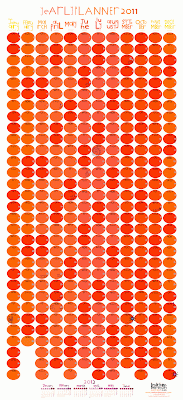Yinka Shonibare, MBE's films can be seen as a natural extension of his photography work. Already creating suites of photographs that, when viewed together, told a story, it isn't surprising that Shonibare soon turned to the medium of film.
Courtesy of Yinka Shonibare, MBE.
Shonibare's first film, Un Ballo in Masquera (2004), uses the story of King Gustav III of Sweden's assassination at a masked ball in 1792, Shonibare's familiar Dutch wax fabrics, dance, and a striking lack of dialogue to explore ideas about gender, power and authority.[1] Film, according to Shonibare, has allowed him to explore movement, something that is impossible to capture with a still image.[2] He explains that, with Un Ballo in Maschera in particular, "I did not want to make a film with a beginning, middle and end; instead, I wanted to explore the reflexivity of the film and how it reflects back on itself...It is a very Modernist approach, I guess, and in Un Ballo in Maschera I use devices such as repetition to draw attention to the filmic nature of what we are seeing."[3] And while the subject of this film draws from a particular obscure historical event, Shonibare was inspired to make it by the current global situation, particularly the war in Iraq.[4] As he explains of this work:
I was thinking about King Gustav III of Sweden, who was fighting many wars on many fronts—with Russia, with Denmark—and spending a lot of money; as a result of this high spending, his population was impoverished, suffering. He was also an actor and a dandy, and he started the art academies in Sweden. He modeled himself on the French court and only spoke French. But he was fiddling while Rome was burning. There was a conspiracy to kill him. He loved masked balls, and he loved the theater, and it was while he was at one of those balls that he was assassinated. So I used him as a metaphor for power and its deconstruction. But there is an opportunity within my film for redemption. Things that happen get undone: the king gets killed, but he gets up again, and at the end of the film he steps backward, out of the scene. And, of course, I also played with gender positions, changing them around. The “power” in my film is a woman, and the assassin is also a woman dressed as a man. [5]
If you want to learn more about Un Ballo in Masquera, as well as watch a video that features clips and Shonibare discussing the film, check out Chapter 4 of this ART:21 video.
Courtesy of Yinka Shonibare, MBE.
Shonibare's second film to date, Odile and Odette (2005), is taken from Tchaikovsky's Swan Lake.[6] Rather than using repetition as a filmic device, Shonibare instead using the device of doubling to tell his story.[7] As Shonibare explains of why he chose this story:
I always like to work with iconic things, and Swan Lake is very well known, probably the most popular ballet. It’s also a perfect choice because the basic story concerns a prince who wants to get married, and there’s a good, sweet swan, Odette, and a bad swan, Odile. Usually the two roles are danced by the same ballerina. In all productions Odile is put into black clothes and Odette wears swanlike, nicer things. The roles—one as the ego and one as alter—in my version are more ambiguous: you would not necessarily be able to tell who is the bad one and who is the good one. One role is danced by a black ballerina and the other is danced by a white ballerina, and between them is an empty gold frame; the ballerinas do solos from Swan Lake, but they mirror each other’s movements, creating the illusion that one dancer is a reflection of the other. The way the piece is lit, it’s actually quite convincing as a reflection.[8]
Once again, Shonibare's choice of film as his medium is used as a way to express movement and narrative, as well as to convey emotion, an impossible feat for other, static works.
[1] Anthony Downey, "Yinka Shonibare," BOMB Magazine online, http://bombsite.com/issues/93/articles/2777, (accessed October 27, 2010).
[2] Anthony Downey, "Setting the Stage: Yinka Shonibare MBE in Conversation with Anthony Downey," Yinka Shonibare MBE, (New York: Prestel Verlag, 2008), 43.
[3] Ibid., 43-4.
[4] Anthony Downey, "Yinka Shonibare," BOMB Magazine online, http://bombsite.com/issues/93/articles/2777, (accessed October 27, 2010).
[5] Ibid.
[6] Anthony Downey, "Setting the Stage: Yinka Shonibare MBE in Conversation with Anthony Downey," Yinka Shonibare MBE, (New York: Prestel Verlag, 2008), 44.
[7] Ibid., 44.
[8] Anthony Downey, "Yinka Shonibare," BOMB Magazine online, http://bombsite.com/issues/93/articles/2777, (accessed October 27, 2010).























.png)









.jpg)
















